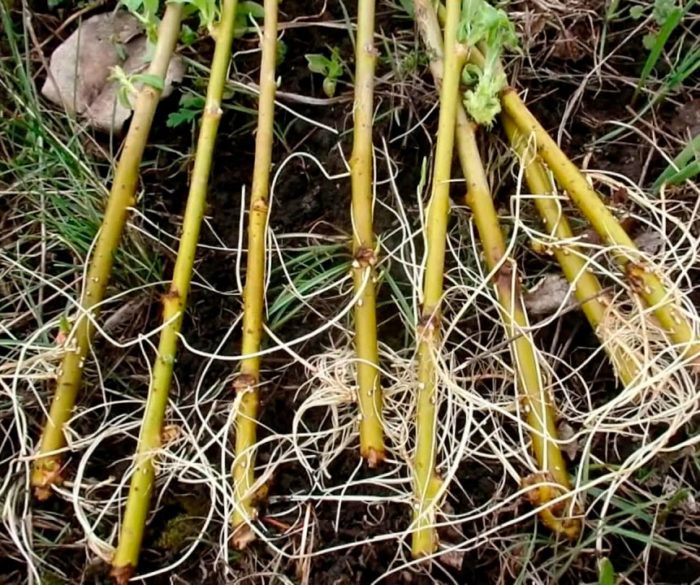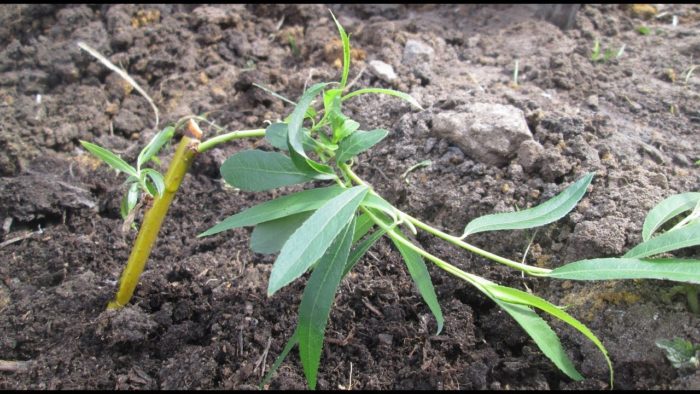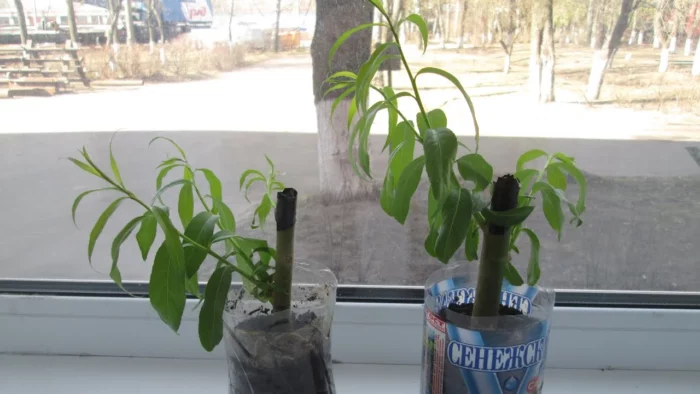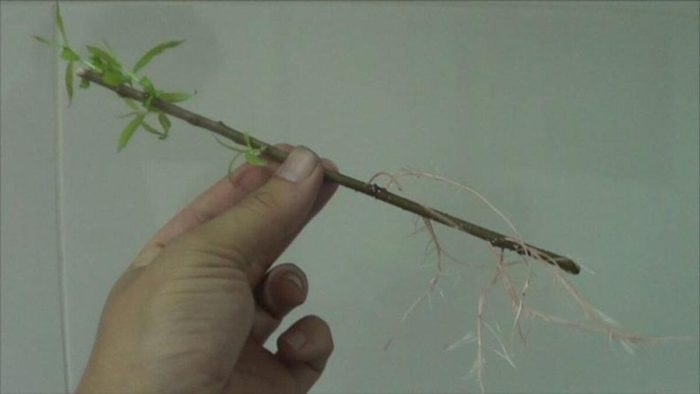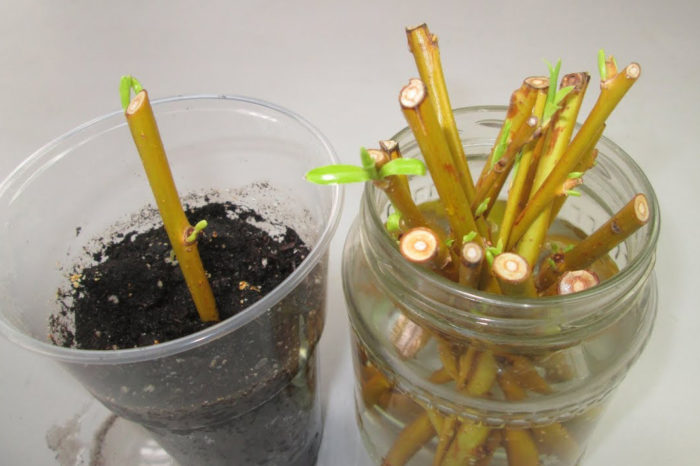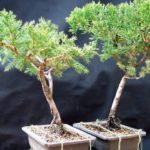The weeping willow is a fairly large tree that mainly grows near rivers and ponds. Its shoots bend towards the ground. This culture is considered very unpretentious. Therefore, even novice gardeners can grow it. At the same time, they often have a question about how to propagate a weeping willow. Most often this is done by cuttings. However, other methods are sometimes used.
What are the ways
There are approximately 100 species of willow and many varieties growing in Russia. In summer cottages, the weeping variety is most often grown. To reproduce it, it is permissible to use the following methods:
- cuttings;
- seed method;
- dividing the bush;
- offspring;
- seeds;
- layering.
In most cases, willow is propagated using cuttings. This method is considered the most accessible. It can be used by both novice gardeners and more experienced gardeners.
Cuttings
The cutting process is influenced by the size of the plant. For shrubs, it is enough to germinate a shoot measuring 15 centimeters. To propagate larger specimens, cuttings at least 25 centimeters long are required. Certain varieties of willow have to be propagated by layering or grafting.
Cuttings have a number of features. To obtain the required results, it is important to adhere to the following rules:
- It is permissible to propagate the plant by cuttings throughout the warm season. However, only in April the rooting parameters reach 95-100%.
- The thicker the branches, the stronger the root system will be obtained.
- To harvest planting material, as a rule, branches are cut from the middle of the shoot. It is important that the cuttings have 1-2 buds in the upper part. In this case, willow shoots form roots along almost the entire length.
- It is necessary to bury the shoots in water by half or at least a third.
- Before breeding, it is important to familiarize yourself with the characteristics of the type and variety of willow that is being propagated. It is worth considering that some varieties have difficulty rooting in the ground.
Rooting
Willow can be safely taken from cuttings. Most likely it will take root. Highly decorative varieties are considered an exception. To achieve the desired results, it is recommended to do the following:
- Cut thick shoots from the tree. This should be done early in the morning.
- Divide the planting material into fragments 15-20 centimeters in size. Cuttings should have 5-7 buds.
- In the lower part, cut the cuttings obliquely, and in the upper part – evenly. This needs to be done directly above the kidney.However, it is not recommended to use thin fragments.
- To prevent moisture loss, wrap the upper part of the cutting with film, treat it with PVA glue or melted paraffin. In the summer, it is necessary to remove leaves from the trunk. In this case, it is enough to leave a minimum amount on top.
- Place the cuttings in a container with water for 2 weeks. It needs to be changed at intervals of 2-3 days.
- Remove the container to a warm place. It is important to provide diffuse lighting.
- Fill the pots with nutritious and loose substrate. If this is not possible, it is permissible to use ordinary garden soil. It is important that containers have drainage holes.
- Bury the cuttings. This needs to be done halfway. After this, it is recommended to straighten the roots and compact the soil.
- Water the seedlings with settled water.
- Leave in the pot for 1 month or until the time is favorable for planting.
At the end of May, willow cuttings are allowed to be moved into open mail. It is recommended to choose long and powerful shoots. Green shoots should be torn off from the branch with a heel.
It is worth considering that in the summer the shoots take root worse than in the winter. To improve their growth, it is recommended to use Kornevin. It is also permissible to use sodium humate. To transplant seedlings into open ground, it is recommended to perform the following steps:
- Take shoots 15-30 centimeters in size and remove the lower leaves.
- Soak the seedlings in a solution of a root formation stimulator and leave for 3-12 hours.
- Loosen the soil in the garden bed. It is recommended to do this to a depth of 50 centimeters. It is also advisable to add sand and fertilizer to the soil.
- Make indentations with a stick.
- Place the cuttings in the holes. This should be done at an angle of 45-50 degrees.
- Press the seedlings tightly with soil and water well.
It is recommended to moisten cuttings planted in the ground abundantly every day. It is recommended to do this for 2-3 weeks. It is important to ensure that the soil does not dry out. To retain moisture, the bed can be covered with a mulch layer. In addition, this procedure will help prevent the growth of weeds.
When propagating willow from cuttings, it can easily be grown in the form of a gazebo or wicker fence. The twigs that grow nearby can be easily woven into a braid-trunk. It is also possible to form a beautiful standard from them.
Graft
Many varieties of willow are grown on a trunk. The functions of a scion can be performed by local species varieties. To propagate a crop using this method, it is permissible to use the following methods:
- budding into splinters;
- copulation in butt.
It is worth considering that even in nurseries it is not always possible to graft willow. In this case, the upper part may die off after some time. It can be much more difficult to plant a willow tree on your own at your dacha.
By layering
Certain varieties of willow are difficult to propagate using cuttings. Therefore, they should be propagated by layering. This procedure is recommended to be carried out in early spring. This method involves rooting branches that have not been separated from the mother culture.
To get the required results, you should do the following:
- Select a shoot at the bottom of the tree, bend it to the surface of the ground and secure it with a metal bracket. To stimulate the process of root formation, it is recommended to make several cuts on the shoot. They should be located at the bottom.
- Sprinkle the shoot with loose soil. In this case, the upper part should remain on the surface.
- Systematically water the cuttings during rooting. After a few weeks, roots will form in a place covered with soil. At the same time, the shoot itself will begin to grow.
- Separate the branch from the mother plant and plant it in a permanent area.
- Tie the seedling to a vertical support. This will help avoid its deformation.
Offspring
Many species of willow form root shoots around the trunk. Female trees usually have significantly more offspring. To use this method, you need to dig up young trees, separate them from the mother crop and plant them in a permanent place. They usually take root very well.
In this way, it is permissible to propagate only self-rooted willows that have not been grafted. If there is no growth near the plant, its growth can be stimulated. This requires cutting down the trunk. This procedure is recommended to be performed at the end of autumn. In this case, by spring the willow will be densely overgrown with branches. At the same time, they will appear not only near the tree, but will also begin to grow directly from the stump. Such shoots are used for weaving and brushwood. The trunk can be cut down at ground level or 1-2 meters from its surface.
Seeds
Willow is almost never propagated this way. The culture has small seeds that are easily spread by the wind and instantly lose their germination capacity. The viability of the seed is affected by the type and variety of the plant. As a rule, after 10 days it is no longer suitable for disembarkation. To preserve seeds for six months, they must be kept in a humid environment. However, it is better to plant the grains immediately after harvesting.
It is recommended to collect willow seeds immediately after ripening - a month after the start of flowering. This should be done in May or July. The maturation of the seed material is indicated by the appearance of fluff on the earrings. Willow seeds are pear-shaped. Under the skin there are 2 cotyledons with embryos at the base.
To obtain seedlings, it is recommended to prepare a substrate. To do this, mix compost and sand in equal parts. The soil needs to be moistened and the seeds scattered. To ensure the required level of humidity, the container should be covered with glass or a bag. After which the container must be moved to a dark and warm place. It is recommended to systematically ventilate and water the plants.
After the sprouts appear, the container should be moved to a place with diffused lighting. In this case, the greenhouse must be removed. Seedlings measuring 1 centimeter should be planted in separate cups. When the seedlings reach 3-5 centimeters, they need to be planted in open ground. It is also acceptable to use a pot with soil.
By division
Some willow varieties reproduce well by dividing the bush. This procedure is recommended to be carried out in the spring - before the start of the growing season. To do this, you need to dig up the bush from different sides and cut off 1-2 trunks. It is recommended to do this with a fragment of the root system. The resulting seedling needs to be moved to a permanent site and watered. The plant will grow well over the season.
Tips and Features
For crop propagation to be successful, it is important to adhere to key recommendations:
- It is worthwhile to prepare cuttings in early spring. This is what buds do. Also, planting material can be cut in the fall - before the arrival of stable cold weather. If necessary, cuttings can be cut in the summer. However, it is important to do this in the evening or in cloudy weather.
- It is important that the mother culture is absolutely healthy. She should not show signs of illness. Trees 5-10 years old are most suitable for taking cuttings. You should not use too young or very old plants.The survival rate of such planting material is significantly reduced.
- To prepare cuttings, you should use a sharp knife or pruning shears. Instruments must first be disinfected. The optimal size of shoots is 15-25 centimeters. The cuttings should have several living buds. In addition, you should not use branches that are too thin. Cut areas on the mother crop must be treated with garden varnish.
- It is recommended to keep cut branches in a cool place before planting. To prevent the cuttings from drying out, they should be wrapped in damp material and placed in a plastic bag. It is better to update the cuttings before planting.
In order for willow propagation to be effective, it is important to choose the right time for a specific method:
- Spring – it is recommended to plant the crop from late February to mid-April. At this time, you can root the cuttings and divide the bushes. Also during this period it is permissible to plant shoots and make layering.
- Summer - Willow seeds ripen at the beginning of this season. However, experts advise taking cuttings during the summer months. It is recommended to remove young twigs of sufficient thickness from the lower leaves and plant them in open ground.
- Autumn - from mid-September to October it is better not to propagate willow. In November, the crop falls asleep, and its sap flow becomes slower. At this time, you can prepare cuttings for rooting in the spring. It is also permissible to add layering. In this case, preference should be given to two-year-old shoots. Thick lignified shoots 25-30 centimeters in size should be used as cuttings. In winter they need to be kept in damp sand. In this case, planting material should be placed in a cool place.
FAQ
Many gardeners have the following questions during the process of willow propagation:
- How does a willow winter when propagating at home? The plant is recommended to be cultivated in open ground. At home, it develops poorly and does not grow so quickly. If it was not possible to plant a seedling in the fall, it is taken to the cellar or to a cool loggia for the winter. The planting material needs to be maintained at a temperature of +10-15 degrees.
- When do cuttings develop roots? This takes on average 5-21 days. The growth rate of the root system depends on the season. In spring they are higher than in summer.
Willow is an excellent ornamental crop, which is propagated by many gardeners. It is important to choose the right breeding method and strictly adhere to the algorithm.

